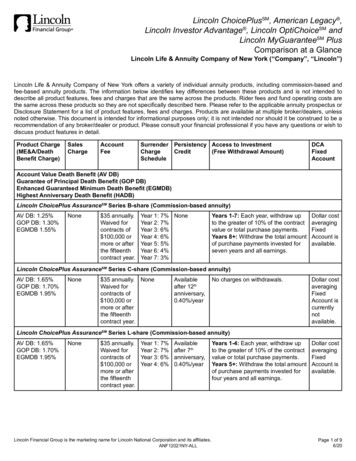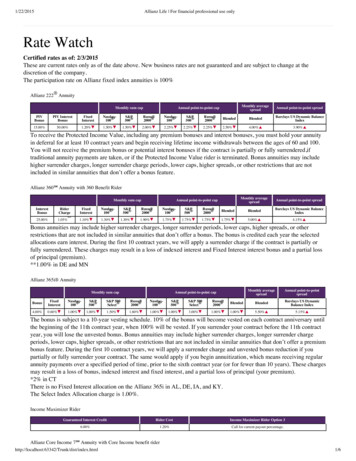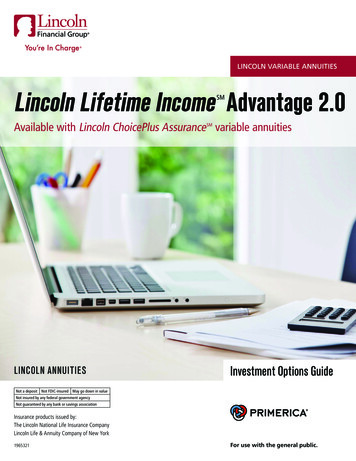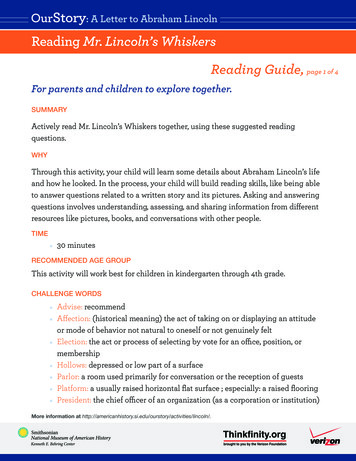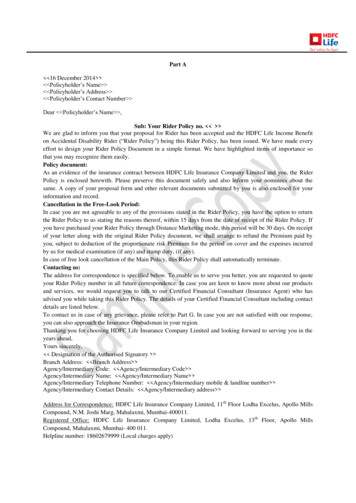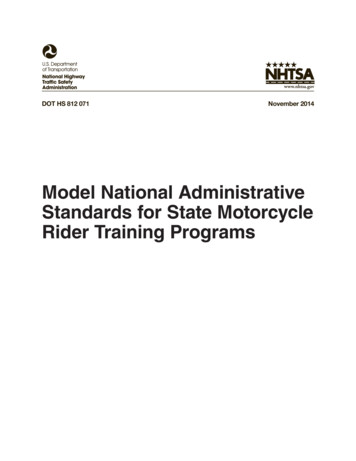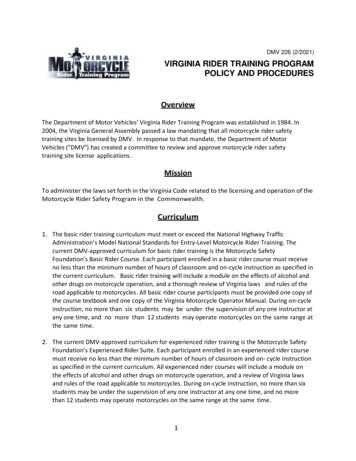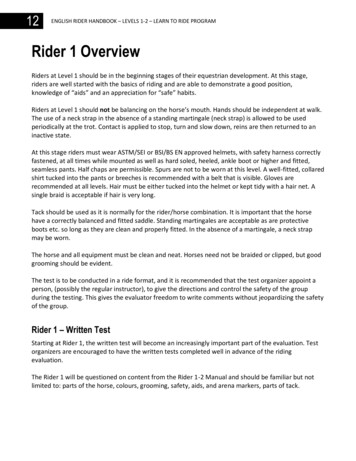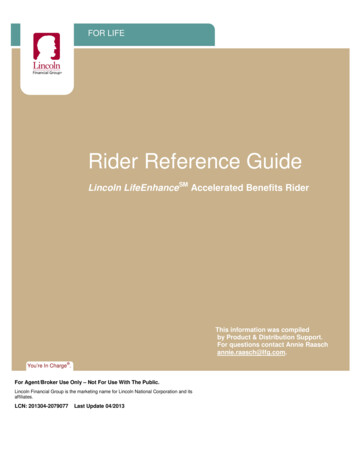
Transcription
FOR LIFERider Reference GuideLincoln LifeEnhanceSM Accelerated Benefits RiderThis information was compiledby Product & Distribution Support.For questions contact Annie Raaschannie.raasch@lfg.com. You’re In Charge .For Agent/Broker Use Only – Not For Use With The Public.Lincoln Financial Group is the marketing name for Lincoln National Corporation and itsaffiliates.LCN: 201304-2079077Last Update 04/2013
Lincoln LifeEnhanceSM ABR Reference GuideLincoln LifeEnhanceSM Accelerated Benefits RiderReference GuideTable of ContentsSMLincoln LifeEnhanceAccelerated Benefits Rider General Informationp. 2Key Rider Featuresp. 2The Application Process Who Can Apply Available Base Products Rider Restrictions Application Supplement Issue Limits Term Conversions/1035 Exchanges Licensing Requirements Rider Cost Agent Compensationp. 2p. 3p. 3p. 3p. 3p. 4p. 4p. 4p. 5p. 5Qualifying for Benefits Qualifications for Benefits Chronic Illness Amount of Acceleration Monthly Benefits Recertification One-Time Lump Sum Benefit Terminal Illness Potential Benefit Payment Combinations Impact of Acceleration on Death Benefit Impact of Acceleration on Policy Values Loans Policy Lapse Protection Impact of Acceleration on Other Riders Policy Changesp. 5p. 5p. 6p. 6p. 6p. 7p. 7p. 7p. 7p. 7p. 8p. 8p. 8p. 9Tax Consequencesp. 9LCN201304-2079077Last Update 04/13Training MaterialNot to be used with the general public
Lincoln LifeEnhanceSM ABR Reference GuideLincoln LifeEnhanceSM Accelerated Benefits RiderGeneral InformationSMLincoln LifeEnhance Accelerated Benefits Rider (ABR) was designed to fit the growing industry needfor an accelerated death benefit triggered by chronic illness. It was also designed for clients who havea primary need for death benefit protection but are also concerned about the impact that chronicillness/terminal illness may have on their financial health.This rider fits as a complementary offering between Lincoln’s existing Accelerated Benefit Riders and Lincoln MoneyGuard .ONE (2012), Lincoln LifeReserveCurrently the rider is available only on new issues of Lincoln VUL Indexed UL Accumulator and Lincoln LifeGuarantee UL (2013), but will be added to other productofferings in the future.Key Rider FeaturesSome of the key features of Lincoln LifeEnhanceSMAccelerated Benefits Rider are: An indemnity benefit – there are no receipts for reimbursement needed; proceeds may beused for any purpose No waiting period – benefits are available immediately once qualification is met Up to 100% of death benefit may be accelerated for chronic illness through a series ofpayments Premium lapse protection – Once acceleration of the death benefit has begun, no additionalpremiums are required and the policy is guaranteed not to lapse as long as no furtherwithdrawals or loans are taken Two benefit payment options for chronic illness:o Monthly benefit option: lower of 2% of the original benefit amount or the IRS per diem limittimes the number of days in the month (may increase annually); payable for 12 months ata time. Recertification required prior to each 12-month period.o One-time lump sum payment discounted for mortality and interest; exercising this optionwill terminate the rider and the policy upon benefit payment. Terminal illness benefit* included in rider:o One-time lump sum payment – lesser of 50% of the death benefit amount or 250,000 Benefits may be payable for both chronic illness and terminal illness concurrently Currently no additional health insurance licensing requirements for agents* Not available in all states.LCN201304-2079077Last update 04/13Training MaterialNot to be used with the general public.2 of 10
Lincoln LifeEnhanceSM ABR Reference GuideThe Application ProcessSMThe Lincoln LifeEnhance Accelerated Benefits Rider is underwritten separately from the base policy andrequires an application supplement to be completed and a disclosure form to be returned to New Businessprior to policy issue. The base policy and the rider may carry different ratings. It is possible to be approvedfor the base product but declined for the rider.Who Can ApplyThe rider is available to individuals ages 20-80 that are rated no higher than Table D on the base policy.Available Base ProductsONE Currently the rider is available with Lincoln VUL(2012) and Lincoln LifeReserve Indexed ULAccumulator only. It will become available with additional products with future product releases.Rider RestrictionsSMLincoln LifeEnhance Accelerated Benefits Rider is not available with:Simplified Issue/Guaranteed IssueAlternate Cash Surrender Value Rider (EXEC Rider)Disability Waiver of Specified Premium RiderGuaranteed Insurability RiderSpouse Term RiderApplication SupplementSMTo apply for Lincoln LifeEnhance Accelerated Benefits Rider, use application LFF06321 (and statevariations) and check off “other” under question #22. Write in the name of the rider, LifeEnhance ABR inthe details section. Do NOT check off Accelerated Benefit Rider which is reserved for the original ABR.See example below.XLifeEnhance ABRIn addition, a supplemental application (LFF10249) must be completed. Essentially, the supplementalapplication contains pre-screening questions. If any of the questions are answered “yes”, the proposedinsured will NOT qualify for LifeEnhance ABR.For issue ages 70 and above, a 10-word delayed recall test will be given during a Personal HistoryInterview and depending upon the results, a Short Portable Mental Status Questionnaire (SPMSQ) mayalso be administered during the Personal History Interview.LCN201304-2079077Last update 04/13Training MaterialNot to be used with the general public.3 of 10
Lincoln LifeEnhanceSM ABR Reference GuideIssue LimitsThe maximum base policy face amount* allowed with the rider is as follows:Issue AgeMaximum Face Amount20-69 5 million70 2 million*Includes any Supplemental Term Insurance Rider on Primary Insured, if available.If more death benefit is needed than the Lincoln LifeEnhance ABR issue limits allow, or if rider costconsiderations are a concern, the policy owner may purchase two policies, one with LifeEnhance ABR andone without. One application should be taken and the following information regarding the second policyinserted into the special instructions section of the application:Please issue an ADDITIONAL contract for a (name of product) policy at “X” face amount withoutthe LifeEnhance ABR. Both policies are to be placed with the total face amount with thisONEas the base product.application to be “Y”. See sample below which uses VULIt is also recommended that the producer call their Underwriting Team Manager to alert them to thisapplication and special processing needed. Failure to follow these application instructions may result inthe policy owner having to sign an amendment.In addition, if the policy owner knows at the time of application that they want to accelerate an amountless than the full death benefit amount, they should apply for two separate policies and the sameinstructions as above should be followed.Term Conversions/1035 ExchangesBoth term conversions and 1035 Exchanges are allowed into policies with the Lincoln LifeEnhanceAccelerated Benefits Rider but the rider will be fully underwritten separately.SMLicensing RequirementsSince this is life insurance, not LTC, currently no additional health insurance license is required.LCN201304-2079077Last update 04/13Training MaterialNot to be used with the general public.4 of 10
Lincoln LifeEnhanceSM ABR Reference GuideRider CostThere is a monthly per 1000 charge for the rider based on the net amount at risk*. Rates are banded asfollows: 0- 249,999 250,000- 499,999*Includes any Supplemental Term InsuranceRider on Primary Insured, if available. 500,000- 999,999 1,000,000- 1,999,999During acceleration, the rider cost will be waived. 2,000,000- 2,999,999 3,000,000- 3,999,999 4,000,000- 5,000,000Agent CompensationAdding the rider will increase the target premium of the base policy. There will be approximately 6%increase to the base product target. All compensation will be terminated at the time of acceleration.Qualifying for BenefitsQualifications for BenefitsThere are different qualifications for chronic illness and terminal illness benefits. The insured will beeligible to receive accelerated benefit payments if all of the following requirements are met:Lincoln receives and approves the following documentation:For Chronic IllnessFor Terminal IllnessWritten Certification or Written Re-certification by aLicensed Health Care Practitioner that the Insuredis Chronically IllWritten Certification by a Licensed Health CarePractitioner that the insured is Terminally IllLincoln receives consent to make such payment, in writing, of any assignee or record name in the policyor any irrevocable beneficiary named under the policy.Lincoln completes, at its discretion and expense, a personal history interview with, and an assessment of,the insured including examination or tests by a Licensed Health Care Practitioner of Lincoln’s choice; andit receives copies of any relevant medical records from a health care provider involved in the insured’scare.LCN201304-2079077Last update 04/13Training MaterialNot to be used with the general public.5 of 10
Lincoln LifeEnhanceSM ABR Reference GuideChronic IllnessChronic Illness means that the insured has been certified within the preceding 12 months, by a LicensedHealth Care Practitioner as:Being unable to perform (without substantialassistance from another individual) at least 2Activities of Daily Living (ADLs) for a period ofat least 90 days due to a loss of functionalcapacity. ADLs include: bathing, continence,dressing, eating, toileting and transferring.orRequiring substantial supervision from anotherindividual to protect the insured from threats tohealth and safety due to severe cognitiveimpairmentandAccording to certification from a Licensed Health Care Practitioner,services are likely to be needed for the rest of the insured’s life.Amount of AccelerationThe total amount available for acceleration due to a chronic illness is 100% of the gross death benefit(death benefit not reduced by indebtedness) at the time of acceleration, through a series of payments.At the time of claim, the gross death benefit is used to determine the Original Benefit Amount*. Onceacceleration begins, this is referred to as the Remaining Benefit Amount.*If available, includes any in force Supplemental Term Insurance Rider on Primary Insured (PITR). If the PITR terminatesduring acceleration, it will not be payable upon the death of the Insured, however it will remain as part of the Remaining BenefitAmount.Monthly BenefitsThe maximum monthly benefit available for each 12 month period for acceleration due to chronicillness is the lesser of:2% of the Original Benefit Amountorthe IRS per diem limittimes the number of days in the monthFor example, the per diem limit for 2012 is 310. In 2013 the per diem limit will be 320. The policymonth is measured from monthly anniversary day to monthly anniversary day. In this example, the firstmonth has a maximum benefit based on the per diem of 9610 ( 310 x 31 days). The maximumbenefit for the second month is 9300 ( 310 x 30 days). The per diem limit may increase each yeardue to an inflation adjustment determined by the IRS, which may factor into the maximum benefitamount available for the following 12 months.In addition, the owner may elect to receive less than the maximum benefit amount. The same Dailybenefit amount would be paid each month for 12 months until recertification. At that time, if the insuredqualifies for benefit, they could select a new benefit amount. Selecting less than the maximum benefitamount would extend the length of time for which the insured may be eligible for benefits.RecertificationIf receiving monthly benefits, recertification by a Licensed Health Care Practitioner will be required priorto each new 12 month benefit period to continue monthly acceleration of the death benefit. The ownermay select either the maximum benefit amount or a new benefit payment amount (less than themaximum) each benefit period.LCN201304-2079077Last update 04/13Training MaterialNot to be used with the general public.6 of 10
Lincoln LifeEnhanceSM ABR Reference GuideOne-Time Lump Sum BenefitThe owner may elect to take the benefit for chronic illness in a one-time lump sum. The benefit isdiscounted for mortality and interest. The earlier benefits are taken, the greater the discount factor.Electing to take benefits in a lump sum will terminate both the rider and the policy upon payment ofbenefit. This payment option may have tax implications and the client should consult their tax advisor.Terminal IllnessTerminal illness means that the insured’s life expectancy is 12 months or less.The total amount available for acceleration due to a terminal illness is the lesser of:50% of theremaining benefit amountor 250,000 of theremaining benefit amountBenefits for terminal illness are automatically issued as a lump sum payment.Potential Benefit Payment CombinationsBenefits may be paid for chronic illness, terminal illness or a combination of both. For example:The owner may elect to start receiving benefits for chronic illness on a monthly basis and later switch to alump sum benefit payment. Remember, receiving benefits for chronic illness in a one-time lump sumpayment will terminate both the rider and the policy.If the owner is receiving monthly benefits for chronic illness and is later diagnosed as terminally ill, theymay receive a lump sum benefit for terminal illness in addition to a continuing monthly chronic illnessbenefit.The owner may start receiving monthly benefits for chronic illness, later qualify for a lump sum terminalillness benefit and finally switch to a lump sum chronic illness benefit. This final payment will terminateboth the rider and the policy.Impact of Acceleration on Death BenefitUpon acceleration, the Death Benefit will be pro-rated down with each benefit payment. This includes theBase and any in force Supplemental Term Insurance Rider on Primary Insured, if applicable.For Lincoln LifeReserve Indexed UL Accumulator, the Minimum Death Benefit Provision states that ifthe death benefit is reduced to zero by debt, the minimum death benefit provision will pay a death benefitof 10,000. This will supersede the Overloan Protection Endorsement. If the Remaining Benefit Amounthas been reduced to zero and an outstanding loan balance still exists the policy will not lapse.Impact of Acceleration on Policy ValuesUpon acceleration, most of the policy values will be pro-rated down, as applicable for the base policy,including, account values, shadow account values and guidelines. Surrender charges which will bewaived. Existing loans are repaid proportionately with each benefit payment. Lincoln will continue to takemonthly deductions but rider charges will stop.For Lincoln LifeReserve Indexed UL Accumulator, the Fixed Account Value will be reduced first,followed by the most recently opened Indexed Segments in successive order. Any existing ParticipatingLoans will be converted to a Fixed Loan.SMSee the Supplemental Acceleration Report in DesignIt to show the effect of benefit payments on policyvalues and death benefits.LCN201304-2079077Last update 04/13Training MaterialNot to be used with the general public.7 of 10
Lincoln LifeEnhanceSM ABR Reference GuideLoansAny loans or reductions taken after acceleration of the death benefit has begun will terminate the rider andthe lapse protection.For policies with outstanding loans, a portion of the benefit payment serves as a loan repayment, resultingin a lower net benefit payment. For very large loans, it is possible for the benefit payment to be reduced tozero. Since the benefit payment can be used for anything the owner wishes, 100% of the benefit may beused to repay a loan if the owner so desires.If the chronic illness one-time lump sum benefit payment is elected, the benefit payment will be reducedby any outstanding loans as well as a morbidity and interest discount factor prior to payment.Policy Lapse ProtectionOnce acceleration benefit payments begin, monthly deductions continue within the policy. If values areinsufficient to take deductions, Lincoln will waive the deductions that would cause the policy to lapse andwill provide full lapse protection. Even if the insured no longer qualifies for the benefit, or chooses to stopacceleration, once acceleration has begun, the policy will not lapse as long as the rider is in force. Noadditional premiums will be required unless otherwise agreed upon by Lincoln and the policy owner. Loanrepayments will continue to be accepted.Remember, loans and withdrawals taken after acceleration of the death benefit has begun will terminatethe rider and the lapse protection.Impact of Acceleration on Other RidersIf the Waiver of Monthly Deductions Rider is attached to the policy and the insured is totally disabled asdefined under the rider, Lincoln will continue to waive deductions which are due once payment of anaccelerated benefit begins.ONEFor VUL, if the Premium Reserve Rider (PRR) is attached to the policy:For chronic illness monthly benefit amountsand terminal illness benefit, the insured mayelect to either include the PRR AccumulationValue in the calculation of the Original BenefitAmount or receive the PRR Surrender Value.Either action will terminate the PRR.If the chronic illness one-time lump sum iselected, the insured will receive a payment of thePPR Surrender Value and the PRR will terminate.The death benefit will then be discounted formortality and interest and the benefit payment willterminate both the rider and the policy.The Enhanced Surrender Value Rider will terminate once payment of accelerated benefits begins.For Lincoln LifeReserve Indexed UL Accumulator:If the Supplemental Term Insurance Rider on Primary Insured (PITR) is attached to the policy, and is stillin force at the time of acceleration the death benefit of the PITR will be included in the calculation of theOriginal Benefit Amount. If PITR terminates during acceleration, it will not be payable upon the death ofthe Insured, however it will remain as part of the Remaining Benefit Amount.The 10-Year Minimum Premium (NLG) Provision will terminate once acceleration begins as the policy isnow lapse protected through the rider.If the Children’s Term Insurance Rider (CTR) terminates due to a one-time lump sum payment or theRemaining Benefit Amount is reduced to zero, the CTR benefit will be paid as paid-up insurance.LCN201304-2079077Last update 04/13Training MaterialNot to be used with the general public.8 of 10
Lincoln LifeEnhanceSM ABR Reference GuidePolicy ChangesSMLincoln LifeEnhance Accelerated Benefits Rider is only available at policy issue and may not be addedafter issue. The rider may be terminated at any time by the policy owner and charges will cease. Thepolicy owner can reinstate the rider as part of the policy if the policy is terminated and reinstated.The following rules apply to policy changes:Policy ChangeBefore Acceleration:After Acceleration:Increases in face amountAllowed as long as the new amountdoes not exceed the issue limits of 5 million for issue ages 20-69 and 2 million for issue ages 70-80.Not allowed.Decreases in face amountAllowedNot allowedRider additions orsubtractionsAllowedNot allowedChange in riskclassificationAllowedNot allowedChange in Death BenefitOptionAllowedNot allowedChange to DBOI prior to the firstbenefit payment is not subject tothe face amount restriction.Tax ConsequencesSMThe Lincoln LifeEnhance Accelerated Benefit Rider is designed so that the benefits paid under the riderwill be treated for federal income tax purposes as accelerated death benefits under Internal RevenueCode Section 101(g) and may be excluded from taxable income depending on the insured’s particularsituation. Depending on the circumstances, benefits under the rider may be taxable as income. Lincolnwill issue a 1099LTC annually for benefits accelerated that year.If there is more than one contract providing accelerated benefits on account of chronic illness and/or aqualified long-term care contract on the insured (whether owned by the same person or not) receipt of allper diem benefit payments must be considered to determine whether the benefits are taxable. To theextent the aggregate per diem benefits for an insured exceed the limits discussed below, the excessbenefit amounts will generally be taxable as ordinary income to the policy owner.Clients should consult a qualified tax advisor prior to purchasing this rider and electing to receivebenefits.In general, per diem benefits payments with respect to an insured are excludable from income to theextent they do not exceed the Per Diem Limit, which is the greater of (1) the then current IRS per diemamount (e.g. 310 per day in 2012) less reimbursements, or (2) the actual qualified costs incurred onbehalf of the insured less reimbursements.Receiving rider benefits will not be impacted by the MEC status of the contract.LCN201304-2079077Last update 04/13Training MaterialNot to be used with the general public.9 of 10
Lincoln LifeEnhanceSM ABR Reference GuideONE2012 policies are issued on policy number LN696 and state variations, and LincolnVULSMLifeEnhance Accelerated Benefits Rider on rider form number LR630 by The Lincoln National Life Insurance Company, Fort Wayne, IN. Lincoln LifeReserve Indexed ULAccumulator policies are issued on policy number UL5062/ ICC12UL5062, and state variations,SMand Lincoln LifeEnhance Accelerated Benefits Rider on rider form number ABR-5762 by The Lincoln National Life Insurance Company, Fort Wayne, IN. Lincoln LifeGuarantee UL policiesSMare issued on policy number UL6000, and Lincoln LifeEnhance Accelerated Benefits Rideron rider form number ABR-7001 by The Lincoln National Life Insurance Company, Fort Wayne,IN. The Lincoln National Life Insurance Company does not solicit business in the state of NewYork, nor is it authorized to do so. Lincoln Financial Group is the marketing name for LincolnNational Corporation and its affiliates. Affiliates are separately responsible for their ownfinancial and contractual obligations. Guarantees are subject to the claims-paying ability of theinsurer. Products and features subject to state availability.Lincoln variable universal life insurance is sold by prospectus. Carefully consider theinvestment objectives, risks, charges, and expenses of the policy and its underlyinginvestment options. The prospectus contains this and other information about the variableproduct and its underlying investment options. A prospectus is available upon request and shouldbe read carefully before investing or sending money. For a current prospectus, please call 800444-2363 or go to www.LincolnFinancial.com.Lincoln Financial Group is the marketing name for Lincoln National Corporation and its affiliates.Affiliates are separately responsible for their own financial and contractual obligations. Guarantees arebacked by the claims-paying ability of the insurer. Products and features subject to state availability.LCN201304-2079077Last update 04/13Training MaterialNot to be used with the general public.10 of 10
The maximum base policy face amount* allowed with the rider is as follows: Issue Age Maximum Face Amount 20-69 5 million 70 2 million *Includes any Supplemental Term Insurance Rider on Primary Insured, if available. If more death benefit is needed than the Lincoln LifeEnhance ABR issue limits allow, or if rider cost
